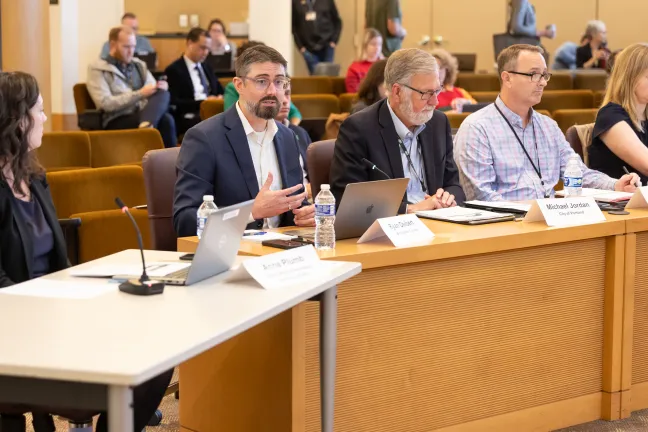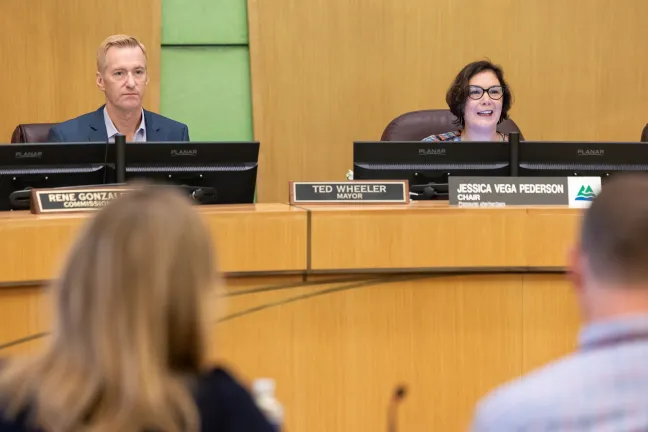Highlighting significant progress in just the first few months of Portland and Multnomah County’s shared homelessness response plan, the newly formed Homelessness Response System provided a public update for elected officials on Tuesday, Oct. 8, in a joint session with the Portland City Council and Multnomah County Board of Commissioners.
The meeting marks the fourth joint meeting on homeless services in the past 13 months — an unprecedented cadence of public briefings reflecting improved and collaborative relationship between the two governments around a shared priority — and their detailed, metric-based roadmap for addressing it.
The Homelessness Response System and Homelessness Response Action Plan were both created in 2024 as part of Portland and Multnomah County’s work to clarify and execute their shared work on homelessness.
The Homelessness Response Action Plan was developed over the course of 18 months by the City and County, and the shelter-focused components of the plan, the Community Sheltering Strategy, were also developed collaboratively across jurisdictions and with community partners. The plan was approved by both the Portland City Council and Multnomah County Board of Commissioners in July 2024 as part of an intergovernmental agreement between the City and County focused on homeless services.
A road map for the next two years, the plan pursues detailed goals and metrics; more transparent budgeting, data sharing and financial reporting; and a new governance structure that broadens and unifies the work of addressing homelessness and root causes beyond just one downstream department, the Joint Office of Homeless Services. The plan also formalizes collaboration between healthcare partners, the justice system, housing providers, service providers, treatment providers and government partners at all levels.
In just two-and-a-half months since the passage of the intergovernmental agreement, officials have completed two-thirds of the action items in the Homelessness Response Action Plan that were to be completed by the end of 2024. Officials have also held three meetings of the Homelessness Response System’s new governing committee since then, in addition to monthly meetings of a new implementation committee that started up in the spring.
That progress and collegiality seen as a result of this work — a new chapter after years of tension around homelessness priorities — comes at a time when the Joint Office of Homeless Services has marked a significant turnaround in efficacy. The Joint Office and its partners rehoused and sheltered thousands more people year over year while also solving challenges that slowed the spending of Supportive Housing Services funds.
In addition to the plan’s specific action items, the Homelessness Response System has either completed or substantially addressed a series of milestones laid out by the Council and Board in a City ordinance and County resolution separate from the terms listed in the intergovernmental agreement.
Key milestones reached
In addition to the significant progress made on action items and milestones, leaders said that a transformation has happened in the way they do the work, with more collaboration across County departments, with the City of Portland, and with other community partners, including Home Forward, Metro, and health systems.
Some of the completed action items and milestones include:
- The Homelessness Response System launching a new public dashboard to track progress toward the Plan’s goals. Early outcomes suggest the system is:
- On track to meet a goal to shelter or house an additional 2,699 people by the end of 2025. That connects with plans to open 429 additional shelter units by December 2024, with plans for more units in 2025.
- On track to house and shelter priority populations (including Black, Indigenous and other people of color and people 55+) at a rate higher than the baseline.
- Exceeding goal for permanent supportive housing retention.
- On track to meet a goal to shelter or house an additional 2,699 people by the end of 2025. That connects with plans to open 429 additional shelter units by December 2024, with plans for more units in 2025.
- The Joint Office developing an outreach and engagement strategy workgroup and steering committee similar to the shelter-focused group that developed the Community Sheltering Strategy.
- The Joint Office reviewing and streamlining shelter services contracting process for faster and more efficient contracting that allows providers to meet workforce needs.
- Multnomah County funding outreach services at libraries.
- The City of Portland identifying 20 commercial buildings in Portland’s central city for potential housing conversion.
- Multnomah County and the City of Portland launching the Homelessness Response System Steering and Oversight Committee and Implementation Committee.
- The Joint Office of Homeless Services launching the pilot of a new Shelter Availability Tool in late August. The pilot is focusing on 11 shelters with set-aside beds that are available to the Street Services Coordination Center Outreach Teams.
- With feedback from the Homelessness Response System’s Steering and Oversight Committee, Chair Vega Pederson directed the Joint Office of Homeless Services to adopt an interim policy that creates guidelines for the distribution of tents and tarps. A final policy will incorporate additional feedback, including from the full Board of County Commissioners, after a public work session in the coming weeks.
- The Homelessness Response System, the Joint Office of Homeless Services and Portland Solutions are working together to plan both short- and long-term strategies to increase exits from shelter into permanent housing.
- The Joint Office’s funding and launch of new day centers and day services and exceeding the goals of Housing Multnomah Now.
As part of the milestones and action items being shared with elected officials, the Joint Office also shared progress on its Community Sheltering Strategy that was presented to City and County elected officials earlier in 2024. They shared that the City and County will be on track to open 429 new shelter units across six shelters by the end of 2024.
The Joint Office said it is still on track to facilitate the opening of a total of 1,000 new shelter units by Dec. 31, 2025, as outlined in the Community Sheltering Strategy.
The Homelessness Response System and the frequent briefings are evidence Multnomah County is committed to moving forward from past challenges and will work steadfastly and collaboratively — with partners across all levels of government, bridging disagreements in the name of the greater good — to reduce homelessness and better serve all of our neighbors.
City and County elected leadership share thoughts
Multnomah County Chair Jessica Vega Pederson said the City and County are working toward needed progress. “This work that we're doing together — the HRAP, the Homeless Response System, the Steering and Oversight Committee — all of this together is really about making a difference in what we're seeing on our streets every day,” she said. “We need to make sure that people who are the most vulnerable, the people who love this city and who love this county, know that we're working for them. So we're going to continue to be transparent, we're going to continue to share the data, we're going to continue to talk about our progress on these things.”
Portland Mayor Ted Wheeler said, “Since the approval of the HRAP and its accompanying agreement just over two months ago, we've seen considerable advancements in our collective mission to address homelessness. Our initial steps have been promising, from my perspective, and it is imperative that we maintain this momentum and continue to refine our approach”
County Commissioner Sharon Meieran said even with the plan, she thinks there is a continued lack of clarity within the City and County’s work on homelessness. “Without a clear delineation of roles and responsibilities, a system can't be built, let alone function,” she said. “I know we always say the public doesn't care who does it, so long as it gets done, and I couldn't agree more. But they assume that amongst ourselves we know what we're supposed to be doing, and that reality is that we don't.”
City Commissioner Mingus Mapps asked for clarification on the role of the Steering and Oversight Committee. “After several months of conversation, I'm still not sure of the purpose of this Steering and Oversight Committee. Is that committee fundamentally an advisory committee or is it a policy-making committee?”
Chair Vega Pederson responded, saying, “It doesn't take away from the authority of the City of Gresham, the City of Portland or Multnomah County and our elected leaders to make budgeting decisions or policy decisions, but what it does is give us a chance to move forward with recommendations from that group that should inform the work of those other jurisdictions.”
City Commissioner Rene Gonzalez offered some comments on the interim tent and tarp distribution guidelines brought forward by the Joint Office. “I think in general, the City and County are looking at those issues with different lenses,” he said. “I proposed a tent and tarp policy to the [Steering and Oversight Committee]. I appreciate the County's response to that. They have in part based a proposed policy on some of the components I proposed. But there's not been any real dialogue in terms of an approval process at the steering committee on what you see before you.”
City Commissioner Dan Ryan said he wanted more emphasis on behavioral health and workforce programs going forward, and said he wanted more clarity on the values behind the work. “I'm missing the vision of what success looks like. I'm missing metrics that get to that point. And then what do we have to do to get there?” he said. “
County Commissioner Julia Brim-Edwards said that while she appreciated the more robust collaboration, she said there needs to be a greater focus on outcomes. “I think we need to always remember that collaboration is not an outcome. With 11,153 people on the streets and probably more people flowing in, we need to continue to focus on outcomes and results, because that's what we're going to be held accountable for,” she said. “We need to focus on the outcome that our community is expecting from us, which is a change to what's happening on the street and in our neighborhoods.”
City Commissioner Carmen Rubio said housing production must continue to be a focus of the work. “As we know, we have a massive shortage of homes in our region, which is at the root of our housing and homelessness crisis. Which is why a lot of elements in the HRAP ultimately rely on housing production. We absolutely must get more units online,” she said, adding that more housing of all types is needed, including permanent supportive housing, affordable housing and private-market housing. “I don't think we have to pick one thing. We need to actively support more of all of them.”
County Commissioner Lori Stegmann urged for continued partnership and collaboration between the City and County on homelessness work. “The people in our community, they don’t care whose responsibility it is. They just want it fixed. And the only way it’s going to get fixed is if we start working together and not against each other,” she said. “It is not an option for us to go our separate ways. We’ve been there, we’ve done that, it didn’t work, it won’t work. This is the only path forward.”
Watch the full session, with full remarks from all elected officials, at youtube.com/MultCoBoard.



